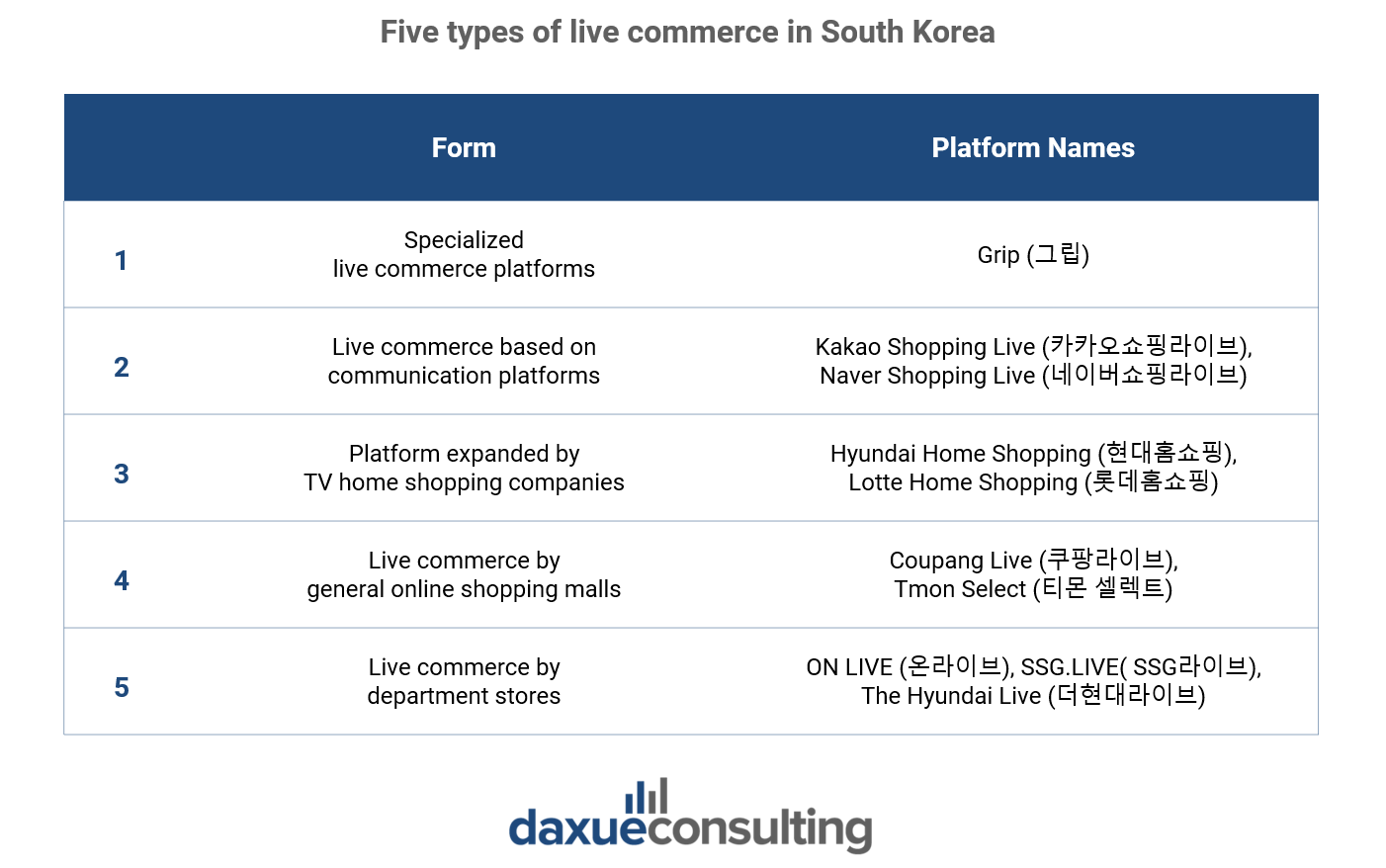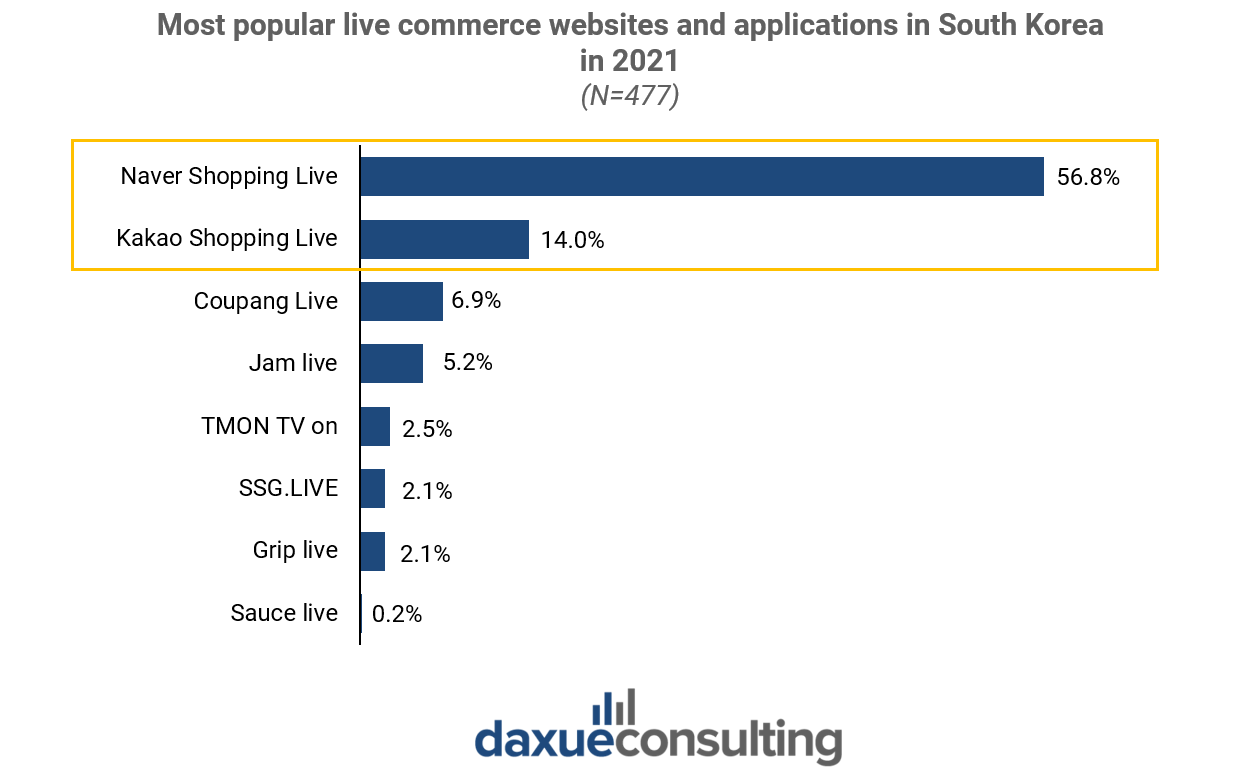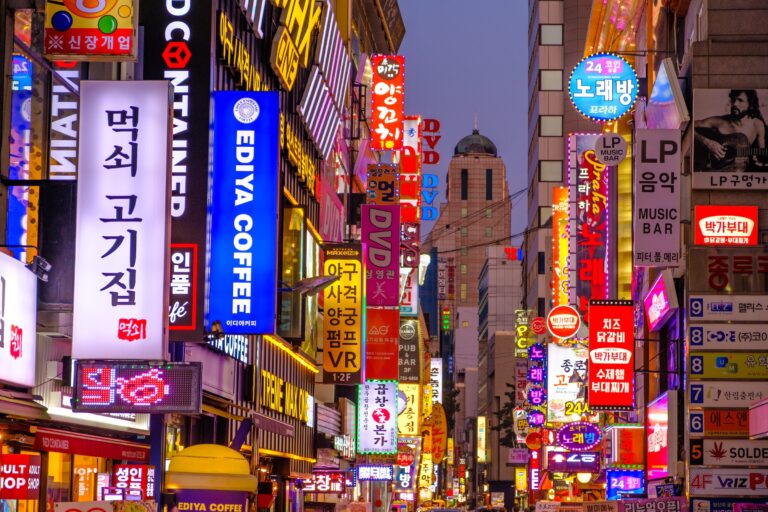South Korea’s live commerce is becoming a must for business in order to adjust to the changing consumer trends including those of the MZ Generation (MZ세대). Although the share of live commerce in the online shopping market was only about 2% as of 2021, it is expected to keep growing. According to a survey by the Seoul Metropolitan Government, the number of people involved in live commerce doubled to 27.4% in 2020 and 57.9% in 2021. By 2023, the market is expected to be worth 10 trillion South Korean won.
Naver (네이버), Coupang (쿠팡), and Shinsegae (신세계) are some of the major companies that have already started to invest into such promising market.

South Korea’s live commerce platforms can be categorized into 5 groups
There are five major types of live commerce in South Korea. The first type is the start-up-based live commerce platform. Grip (그립) is a good example of such kind of category: although it was acquired by Kakao Corp in 2021, it was first founded by Hanna Kim in 2019. The second form is live commerce developed by traditional communication platforms such as Naver (네이버) and Kakao (카카오).

The third one is live commerce stemming from the existing TV home shopping such as Hyundai Home Shopping. Traditionally products were sold in real-time only through TV, but now they can also be sold online. The fourth type involves the general online marketplaces such as Coupang (쿠팡) who launched Coupang Live in 2020. The last form of live commerce is managed by large department stores such as those under the chaebol Lotte (롯데) and SSG (신세계). As live commerce develops, it is likely new categories will appear.
Rising demand for “ontact” (언택트) services and new content
There are several reasons that can be attributed to the growing popularity of live commerce in South Korea. First, consumers are eager to communicate with their brands. “Untact” (compound word of “un” and “contact”, 언택트) services, referring to those that are contactless including contactless self-service kiosks, are widely available. However, not being enough for consumers who want to have a conversation with their brands, “ontact” (compound word of “on” and contact”, 오택트) services, those provided online like live commerce, have become more widely available.
Another reason for the growth of live commerce is that consumers can experience more new content. In particular, rather than the sophisticated traditional videos or TV home shopping, people can get an unfiltered view of the products and experience different settings. Since regulation is more relaxed in live commerce, companies can leverage more stimulating ways of entertaining consumers and film in different places beyond the traditional studio.
Trust is key for South Korean consumers, including the MZ Generation
Trust is another major reason for consumers turning to live commerce. Brands opening a two-way channel that allows viewers to ask real-time questions and share their concerns with them helps build a stronger relationship and understanding between the two sides. The MZ Generation (MZ세대), for example, seeks for a “meaning-out” lifestyle, where they make value-driven consumption choices. Live commerce is a medium through which brands can verbally and physically share their values.
Competition between Naver and Kakao but future winner is unknown
Naver and Kakao are the top leaders of South Korea’s live commerce market. Although Kakao Live was launched a few months earlier than Naver’s live shopping platform in 2020, Naver Shopping Live has been able to take the number one position. However, the final winner is uncertain since they’re leveraging different strengths and strategies.

Naver’s live commerce platforms aims to help SMEs by leveraging its advanced tech
As for Naver, its strengths include the low entry barrier for small and medium-sized businesses (SMEs) and comprehensive consulting services for brands. For example, it provides live commerce tools for members of its Naver Smart Store (네이버 스마트 스토어). In fact, the average sales of the members increased by 48% from May 2020 to September 2021 after being part of Naver Shopping Live (네이버 쇼핑 라이브). Foreign brands can also be members, but regulations are strengthening in order to minimize problems including the rise of counterfeit products. Building an app specific for its live commerce and combining AI-powered solutions as well as other advanced technologies with live commerce to support its merchants are part of its future strategies.
Kakao focuses on high quality content and expanding abroad
Kakao, the other competitor, adopted a drastically different approach. Rather than focusing on SMEs, they are focusing on a narrower target in order to deliver high-quality content. To do that, they supervise their Kakao Shopping Live more directly from production to transmission. Moreover, unlike Naver, they need a separate app as it can be integrated it to its existing messaging app. In the future, Kakao hopes to amplify the synergy between the company and its affiliate Grip (그립). They will not only target businesses in South Korea but also international ones to increase their scope to a global level.
Key insights into the promising South Korea’s live commerce market
- South Korea’s live commerce only accounts for a small share of the domestic online shopping market. However, that’s not necessarily a reason for brands to disregard it. It has grown rapidly during the Covid-19 period, especially among the MZ Generation (MZ세대). It is expected to further grow in the future for reasons including the rising demand for “ontact” (온택트) services, opportunity to make new content desired by the consumers, and the need for a trustworthy brand.
- Even though it’s a relatively new market, several companies operating in different sectors, from the traditional TV home shopping to large department stores, are building their live commerce platforms. This provides a lot more options for local and foreign brands to choose from and sell their products according to their strategies.
- The most popular live commerce platforms in South Korea is Naver Shopping Live (네이버 쇼핑라이브), Kakao Shopping Live (카카오쇼핑라이브), and Coupang Live (쿠팡 라이브).





